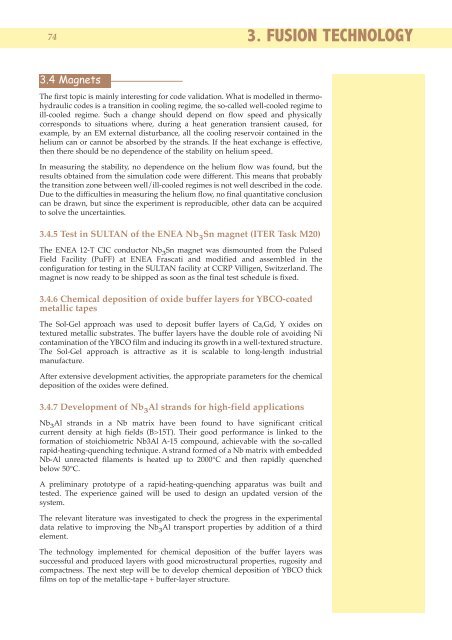1. magnetic confinement - ENEA - Fusione
1. magnetic confinement - ENEA - Fusione
1. magnetic confinement - ENEA - Fusione
You also want an ePaper? Increase the reach of your titles
YUMPU automatically turns print PDFs into web optimized ePapers that Google loves.
74<br />
3. FUSION TECHNOLOGY<br />
3.4 Magnets<br />
The first topic is mainly interesting for code validation. What is modelled in thermohydraulic<br />
codes is a transition in cooling regime, the so-called well-cooled regime to<br />
ill-cooled regime. Such a change should depend on flow speed and physically<br />
corresponds to situations where, during a heat generation transient caused, for<br />
example, by an EM external disturbance, all the cooling reservoir contained in the<br />
helium can or cannot be absorbed by the strands. If the heat exchange is effective,<br />
then there should be no dependence of the stability on helium speed.<br />
In measuring the stability, no dependence on the helium flow was found, but the<br />
results obtained from the simulation code were different. This means that probably<br />
the transition zone between well/ill-cooled regimes is not well described in the code.<br />
Due to the difficulties in measuring the helium flow, no final quantitative conclusion<br />
can be drawn, but since the experiment is reproducible, other data can be acquired<br />
to solve the uncertainties.<br />
3.4.5 Test in SULTAN of the <strong>ENEA</strong> Nb 3<br />
Sn magnet (ITER Task M20)<br />
The <strong>ENEA</strong> 12-T CIC conductor Nb 3 Sn magnet was dismounted from the Pulsed<br />
Field Facility (PuFF) at <strong>ENEA</strong> Frascati and modified and assembled in the<br />
configuration for testing in the SULTAN facility at CCRP Villigen, Switzerland. The<br />
magnet is now ready to be shipped as soon as the final test schedule is fixed.<br />
3.4.6 Chemical deposition of oxide buffer layers for YBCO-coated<br />
metallic tapes<br />
The Sol-Gel approach was used to deposit buffer layers of Ca,Gd, Y oxides on<br />
textured metallic substrates. The buffer layers have the double role of avoiding Ni<br />
contamination of the YBCO film and inducing its growth in a well-textured structure.<br />
The Sol-Gel approach is attractive as it is scalable to long-length industrial<br />
manufacture.<br />
After extensive development activities, the appropriate parameters for the chemical<br />
deposition of the oxides were defined.<br />
3.4.7 Development of Nb 3<br />
Al strands for high-field applications<br />
Nb 3 Al strands in a Nb matrix have been found to have significant critical<br />
current density at high fields (B>15T). Their good performance is linked to the<br />
formation of stoichiometric Nb3Al A-15 compound, achievable with the so-called<br />
rapid-heating-quenching technique. A strand formed of a Nb matrix with embedded<br />
Nb-Al unreacted filaments is heated up to 2000°C and then rapidly quenched<br />
below 50°C.<br />
A preliminary prototype of a rapid-heating-quenching apparatus was built and<br />
tested. The experience gained will be used to design an updated version of the<br />
system.<br />
The relevant literature was investigated to check the progress in the experimental<br />
data relative to improving the Nb 3 Al transport properties by addition of a third<br />
element.<br />
The technology implemented for chemical deposition of the buffer layers was<br />
successful and produced layers with good microstructural properties, rugosity and<br />
compactness. The next step will be to develop chemical deposition of YBCO thick<br />
films on top of the metallic-tape + buffer-layer structure.













